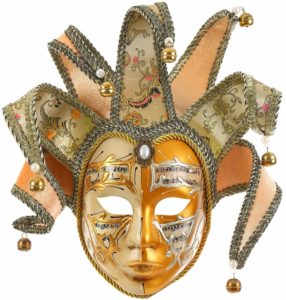The Carnival of Venice [which this year runs from 8-25 February] was started from a victory of the Venice Republic against the Patriarch of Aquileia, Ulrico di Treven, in the year 1162. In the honour of this victory, the people started to dance and gather in Piazza San Marco. However, under the rule of the Holy Roman Emperor and later Emperor of Austria, Francis II, the festival was outlawed entirely in 1797 and the use of masks became strictly forbidden.

After a long absence, the Carnival returned in 1979.The Italian government decided to bring back the history and culture of Venice and sought to use the traditional Carnival as the centrepiece of its efforts. Approximately three million visitors come to Venice every year for the Carnival. One of the most important events is the contest for la maschera più bella (“the most beautiful mask”) which is judged by a panel of international costume and fashion designers.

Masks have always been an important feature of the Venetian carnival. Traditionally people were allowed to wear them between the festival of Santo Stefano (St. Stephen’s Day, 26 December) and the end of the carnival season at midnight of Shrove Tuesday. As masks were also allowed on Ascension and from 5 October to Christmas, people could spend a large portion of the year in disguise. Maskmakers (mascherari) enjoyed a special position in society, with their own laws and their own guild.

Venetian masks can be made of leather, porcelain or using the original glass technique. The original masks were rather simple in design, decoration, and often had a symbolic and practical function. Nowadays, most Italian masks are made with the application of gesso and gold leaf and are hand-painted using natural feathers and gems to decorate.

As to the reasons for the earliest masks being worn in Venice, one scholar argues that covering the face in public was a uniquely Venetian response to one of the most rigid class hierarchies in European history. During Carnival, the sumptuary laws were suspended and people could dress as they liked, instead of according to the rules that were set down in law for their profession and social class.
The first documented sources mentioning the use of masks in Venice can be found as far back as the 13th century. The Great Council made it a crime for masked people to throw scented eggs.These ovi odoriferi were eggshells that were usually filled with rose water perfume and tossed by young men at their friends or at young women they admired. However, in some cases, the eggs were filled with ink or other damaging substances!

Join the discussion
0 people are already talking about this, why not let us know what you think?